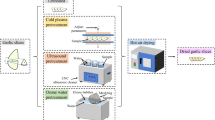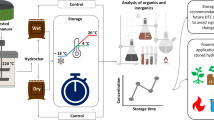Abstract
Ohmic heating is an alternative heating technique, using an electrical current passing through the food product. It can be specially used in pumpable food lines as an alternative heating unit. In this study, orange juice concentrates having 0.20–0.60 mass fraction soluble solids were ohmically heated by using five different voltage gradients (20–60 V/cm). The dependence of electrical conductivity on temperature, voltage gradient and concentration were measured. The ohmic heating system performance coefficients were calculated by using the energies given to the system and taken by the orange juice samples. The mathematical model results, taking system performance coefficients into account, were compared with experimental ones. The predictions of the mathematical model were found to be very accurate.





Similar content being viewed by others
Abbreviations
- A:
-
Heat transfer area based on outer surface of test tube (m2)
- Ae:
-
Area of cross-section of the electrodes (m2)
- B1:
-
Empirical temperature constant (S/mK), Table 3
- B2:
-
Empirical temperature constant (S/mK), Eq. 13
- B3:
-
Empirical temperature constant (S/mK), Eq. 14
- B4:
-
Empirical temperature constant (S/mK), Eq. 15
- C1:
-
Empirical constant (S/m), Table 3
- C2:
-
Empirical constant (S/m), Eq. 13
- C3:
-
Empirical constant (S/m), Eq. 14
- C4:
-
Empirical constant (S/m), Eq. 15
- conc:
-
Total soluble solid concentration of the orange juice (mass fraction)
- Cp:
-
Specific heat capacity (J/kg K)
- D1:
-
Empirical voltage gradient constant (S/m(cm/V)−N1), Eq. 13
- D2:
-
Empirical voltage gradient constant (S/m(cm/V)−N2), Eq. 15
- \( {\mathop {E_{{{\text{loss}}}} }\limits^ \bullet } \) :
-
Rate of energy loss (W)
- E:
-
Amount of heat (J)
- E1:
-
Empirical concentration constant (S/m (mass fraction×100)−N2), Eq. 14
- E2:
-
Empirical concentration constant (S/m (mass fraction×100)−N2), Eq. 15
- h:
-
Heat transfer coefficient (W/m2K)
- I:
-
Current (Ampere)
- k:
-
Thermal conductivity of the sample (W/mK)
- Kc:
-
Cell constant (1/m)
- L:
-
Distance between the electrodes (m)
- m:
-
Mass of the sample (kg)
- Q:
-
Amount of heat (J)
- R:
-
Resistance of the sample (m)
- t:
-
Time (s)
- T:
-
Temperature (°C)
- \( {\mathop u\limits^ \bullet } \) :
-
Internal energy generation (W/m3)
- v:
-
Volume of the sample (m3)
- V:
-
Voltage applied (V)
- Xw:
-
Weight fraction of the water in the sample
- ρ:
-
Density of the sample (kg/m3)
- σ:
-
Specific electrical conductivity (S/m)
- acc:
-
Accumulated
- amb:
-
Ambient
- exp:
-
Experimental
- fin:
-
Final temperature
- gen:
-
Generated
- in:
-
Initial temperature
- nc:
-
Natural convection
- P:
-
Predicted assuming Qloss to be equal to zero
- T:
-
Temperature dependent
- TC:
-
Temperature and concentration dependent
- TV:
-
Temperature and voltage gradient dependent
- w:
-
At wall
- N1:
-
Constant in Eq. 13
- N2:
-
Constant in Eq. 14
- N3:
-
Constant in Eq. 15
- N4:
-
Constant in Eq. 15
References
Reznick D (1996) Food Technol 50(5):250–251
Sastry SK (1989) Presented at the 5th Int Congress Eng Food 1989, Cologne, Germany, 28 May–03 June
Sastry SK, Li Q (1996) Food Technol 50(5):246–248
Parrott DL (1992) Food Technol December: 68–72
Palaniappan S, Sastry SK (1991) J Food Process Eng 14:247–260
Qihua T, Jindal VK, van Winden J (1993) Computers and Electronics in Agriculture 9:243–253
Lima M, Heskitt BF, Burianek LL, Nokes SE, Sastry SK (1999) J Food Processing Preservation 23:421–434
Zhao Y Kolbe E (1999) J Food Process Eng 22:81–89
Assiry A, Sastry SK, Samaranayake C (2003) J Appl Electrochem 33(2):187–196
Sastry SK, Barach JT (2000) J Food Sci 65(4):42–46
Anonymous (2002) Italian Food Beverage Technol 27:28–29
Wang WC, Sastry SK (1993) J Food Eng 20:311–323
Sastry SK, Salengke S (1998) J Food Process Eng 21:441–458
Sastry SK, Palaniappan S (1992) J Food Process Eng 15:241–261
Incorpera FP, De Witt DP (1993) Introduction to heat transfer, 2nd edn. Wiley, New York
Geankoplis CJ (1993) Transport processes and unit operations, 3rd edn. Prentice-Hall, pp 205–370
Sweat VE (1995) In: Rao MA, Rizvi SSH (eds) Engineering properties of foods, 2nd edn. Dekker, New York, pp 99–136
Castro I, Teixeira JA, Salengke S, Sastry SK, Vicente AA (2003) J Food Process Eng 26(1):17–30
SPSS (1999) SPSS Statistical Package for Windows, V 10.0. SPSS, Chicago
Acknowledgement
This study was partially supported by Ege University Science-Technology Research and Application Center (EBILTEM) Project No: 2001/BIL/002, Ege University Scientific Projects Fund Project No: 2001/MUH/03, ETAP Agricultural and Food Products Packaging SA Turkey and Pinar Dairy Products SA Turkey.
Author information
Authors and Affiliations
Corresponding author
Rights and permissions
About this article
Cite this article
Icier, F., Ilicali, C. The effects of concentration on electrical conductivity of orange juice concentrates during ohmic heating. Eur Food Res Technol 220, 406–414 (2005). https://doi.org/10.1007/s00217-004-1043-x
Received:
Revised:
Published:
Issue Date:
DOI: https://doi.org/10.1007/s00217-004-1043-x




